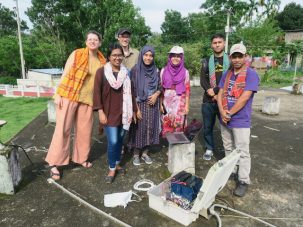Geohazards in Bangladesh3
-

Start of the Mini-Field School
We were joined in our electromagnetic investigation of the subsurface and earthquake hazard by a group of US and Bangladeshi students and professors for a mini-Field School.
-

Tea Gardens to the Rescue
We switched to deploying our equipment for imaging faults and the structure beneath the surface to tea gardens to get away from power lines and buried the cables to protect them from gnawing foxes.
-

Dealing With Rain and Rats
As we continued our geophysical measurements, we had to deal with heavy rains, flooding fields, and rats and foxes biting our cables. Many cables were broken soon after sunset, ruining the measurements.
-

Fieldwork in Bangladesh During the End of Ramadan and Eid Festival
We have come to in Bangladesh in the pre-monsoon heat to better image the active faults beneath the surface using electromagnetic instruments. We are using the fallow fields from the just-harvested rice crop for our sites.
-

Struggling With Towed Equipment, Repairing GPS, and Home
We switched to a towed electromagnetic system to image the fresh and saline groundwater in Bangladesh, and ran into a variety of problems, including high winds, strong currents and running aground.
-

Continuing the Survey: Watermelon and Winds
Continuing our electromagnetic survey of fresh and saline groundwater, we saw the landscape change from lush watermelon fields to fallow rice fields as the salinity increased towards the sea.
-

Barisal and the Eastern Channel
We are continuing our measurements of fresh and saline groundwater in Bangladesh using electromagnetic instruments. We finished our first set of measurements and have now shifted farther east near Barisal where groundwater is fresher.
-

Deploying in the Mangrove Forest
We continued our electromagnetic expedition to image fresh and saline groundwater into the Sundarbans Mangrove Forest, the world’s largest. While guards protected us from tigers, it was a wild boar that dug up some of our equipment.
-

Sailing Around the Bangladesh Coastal Zone
I am back in Bangladesh to explore the distribution of fresh and saline groundwater in the coastal zone, needed for drinking in the dry season.

AGU25, the premier Earth and space science conference, takes place December 15-19, 2025 in New Orleans, Louisiana. This year’s theme—Where Science Connects Us—puts in focus how science depends on connection, from the lab to the field to the ballot box. Once again, Lamont-Doherty Earth Observatory and Columbia Climate School scientists, experts, students, and educators are playing an active role, sharing our research and helping shape the future of our planet. #AGU25 Learn More
